Being a general contractor, it is very tough to hold onto clients in such a competitive industry. In this new digital era, where people are buying products before researching online and comparing prices, it is essential to stand out and provide exceptional service to retain clients.
97% of consumers use the internet to look for local services, and 93% of those searches begin with a search engine. So you need to implement a search engine optimization strategy for your website. This will help your business appear higher in search engine results and attract more potential clients. However, local SEO for contractors is the best way to increase online exposure for your business in your specific geographic area. When you attract regional clients, it automatically expands your services in multiple areas.
Though various online strategies can expand your online presence, local contractor SEO is specifically designed to target potential customers in your local community. SEO can generate 1,000%+ more traffic than organic social media platforms.
In this blog, you will get all the best local SEO tips to improve SEO for contractors’ strategy to improve online presence. You can get to know about industry trends of contractors, and then you can create local SEO campaigns and design content for specific areas. Most importantly, you will learn how to maintain a website to improve local search rankings and what the best local keywords are to include in local landing pages. So, let’s jump into the core of local SEO tips for contractors.
What Is Local SEO for Contractors and Why Is It Important?
Search engine optimization, or local SEO for contractors, is the process of improving your website’s visibility to appear higher in local search results. For contractors, this means appearing in searches like “Decks and Patios” or “roofing services in [City]. The main elements of local contractor SEO are location-specific content creation, maintaining consistent NAP (Name, Address, Phone) information across directories, and optimizing your Google Business Profile.
Why Is It Important?
For contractors, local SEO is important since it has a direct effect on exposure and client registration. According to a report, 46% of Google searches have local intent, and 76% of people who search locally visit a business within a day. Moreover, 88% of mobile local searches lead to a visit or call within a day. It shows the importance of being discoverable on mobile devices.
These incredible statistics show the need for local SEO for contractors. It will increase awareness and attract more potential clients to the business.
Top 7 Local SEO Strategies Contractors Must Use to Win More Local Clients
After knowing the detailed definition and importance of SEO for contractors, here you get the most useful 7 local SEO strategies to improve the online exposure of contractors.
- How Does Google Business Profile Impact Your Contractor Business?
A comprehensive Google Business Profile increases local search engine visibility for your contractor business, increases credibility, and attracts more local clients directly to your website or phone number.
Importance Of Google Business Profile
- You can improve your online visibility on search engines (Google Search & Maps) and in local search results with the help of a Google Business Profile.
- Then it helps customers to find your services across multiple cities or service areas when configured correctly.
- When you set up your Google Business Profile correctly, it shows at the top of search results. It can turn more local customers into sales because people can see reviews, photos, and deals, and click to call.
- Makes your business found online quickly—great for emergency trades (plumbing, HVAC, roofing). It helps potential customers to easily contact you for immediate service.
Detailed Steps to Set Up Your Google Business Profile
Step 1: Go to Google Business Profile Manager
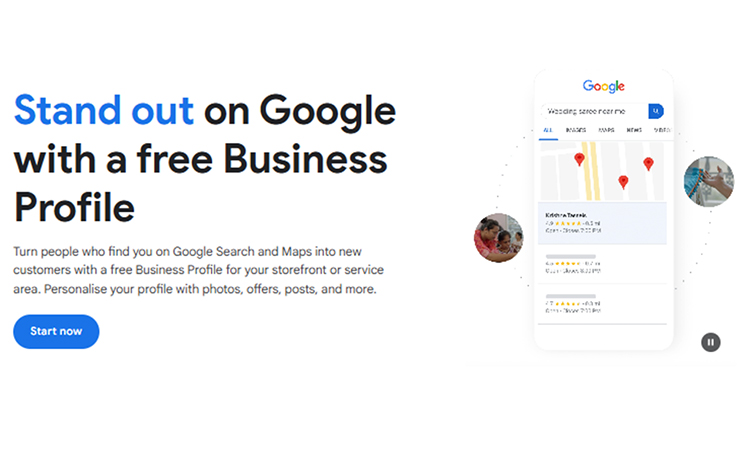
- Visit business.google.com.
- Sign in with your Google account (use a professional business email if possible).
Step 2: Add or Claim Your Business
- Search if your business already exists (Google may have auto-created a profile).
- If it exists → click Claim this business.
- If not → click Add your business to Google.
Step 3: Enter Business Name & Category
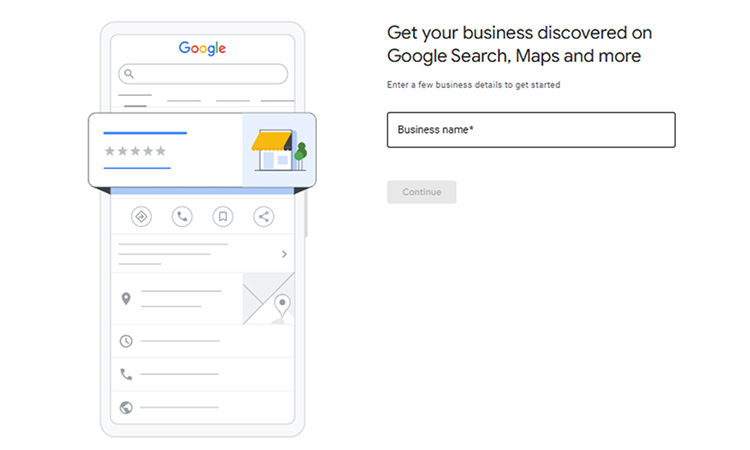
- Type your exact business name (avoid keywords like “Best Roofer in New York”).

- Then you need to choose the primary category (e.g., “Plumber,” “Roofer,” “HVAC Contractor”).
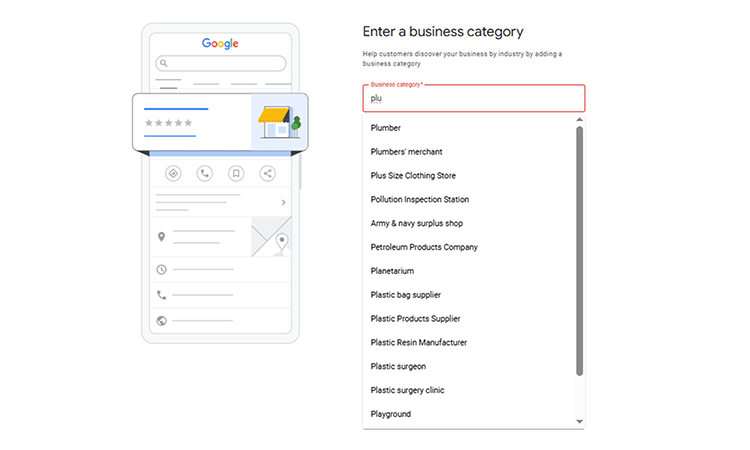
- You can add secondary categories later (e.g., “Bathroom Remodeler,” “Electrician”).
Step 4: Add Location or Service Area
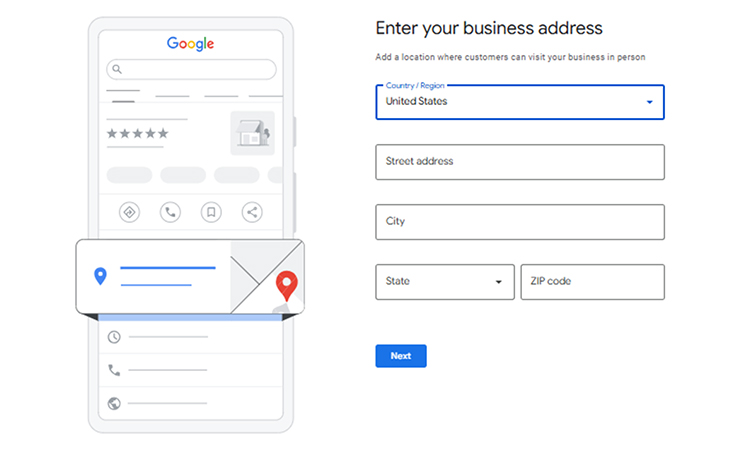
- If you have a shop/office → enter the physical address.

- If you serve multiple cities (like contractors usually do) → choose “I deliver goods and services to customers” → enter service areas (cities, ZIP codes).
Step 5: Add Contact Information
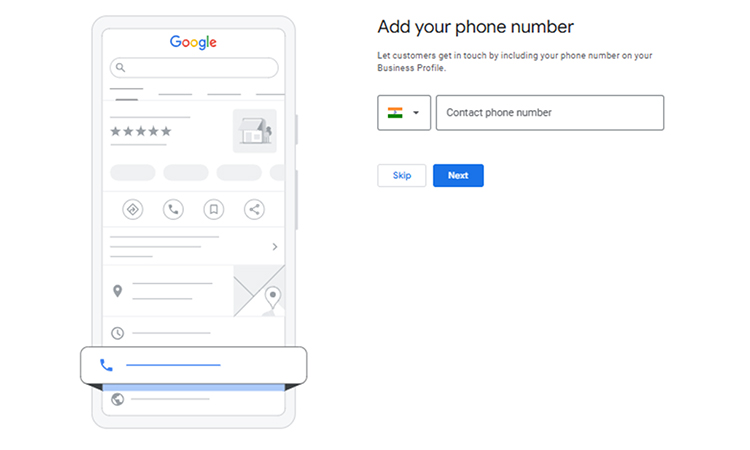
- Phone number (preferably a dedicated business line).
- Website URL (use HTTPS).
- You need to make sure your NAP (Name, Address, Phone) is consistent with all local directories.
Step 6: Verify Your Business
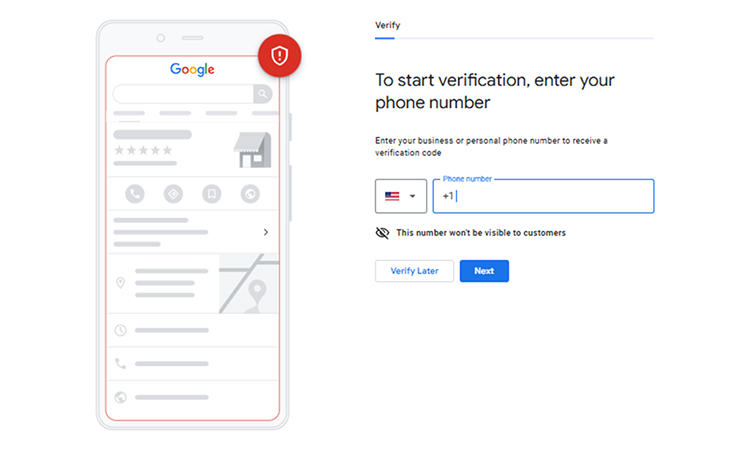
- Google will ask for verification (via postcard, phone, email, or video). So your address and phone number should be the same on all online platforms.
- Complete this step to make your profile active.
Step 7: Add Business Hours & Services
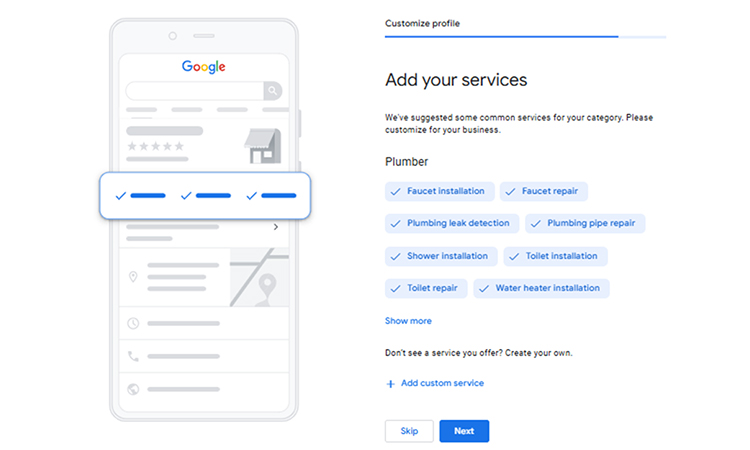
- Set accurate working hours (include emergency hours if applicable).
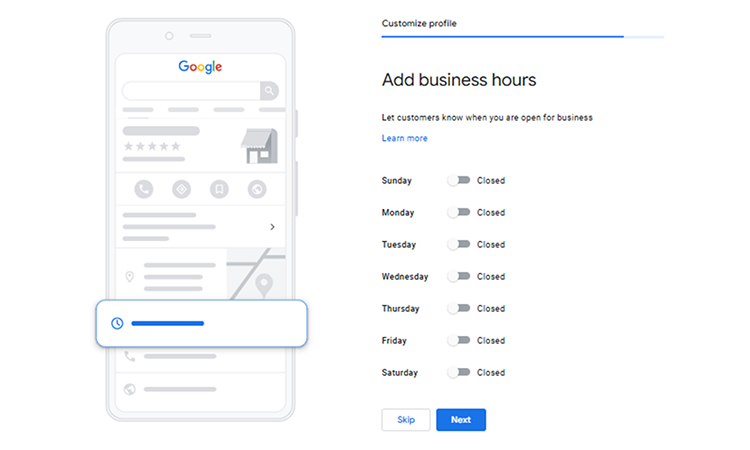
Step 8: Add Photos & Logo
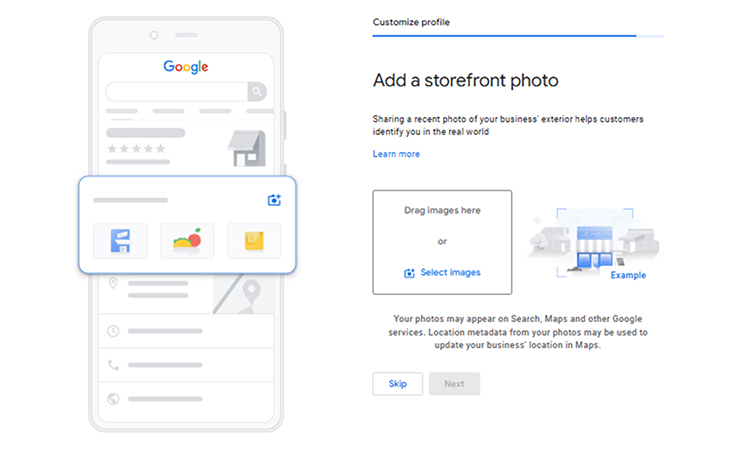
- Upload a clear logo and cover photo.
- Then you need to add high-quality photos of projects, team, equipment, and before/after shots.
- Most of the local businesses with photos get 42% more direction requests and 35% more website clicks.
Step 9: Write a Business Description

- 750 characters, use keywords naturally: e.g., “We are a roofing contractor serving Dallas, helping homeowners with roof repair, replacement, and inspections.”
Step 10: Collect & Manage Reviews
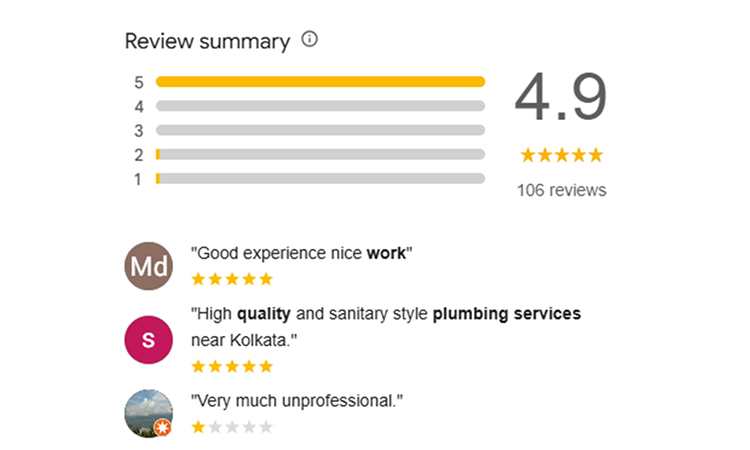
- You can ask your happy clients to leave reviews.
- Respond to all reviews (positive & negative) politely.
- Reviews boost trust and local search results ranking.
Step 11: Keep Updating Your Profile
- Post offers, photos, and seasonal services.
- Then you can use Google Business Profile Insights to see how many people found you on search engines.
- How to Conduct Effective Local Keyword Research for Contractors?
Keywords are those specific terms that your target audience uses to search for your specific product or services. So, you need to collect those words and incorporate relevant keywords into your website content to improve your local SEO.
- Best Keyword research tools
You can use a mix of free + paid: Google Keyword Planner, Google Search Console, Ubersuggest, Ahrefs, SEMrush, AnswerThePublic / AlsoAsked,
- How to Research Keywords on Ubersuggest — Step-By-Step
- Open Ubersuggest and sign in.
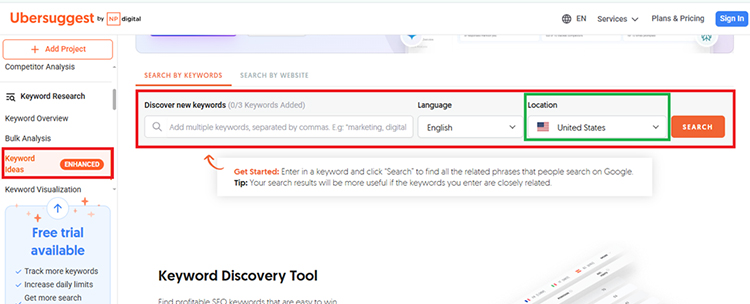
Enter Your Main Keywords in the search results.
- Set your location/language: at the top (choose your country and city/region, if available) — this narrows the results to your specific market. It helps you target keywords relevant to your local area.
- Check the Keyword Overview:
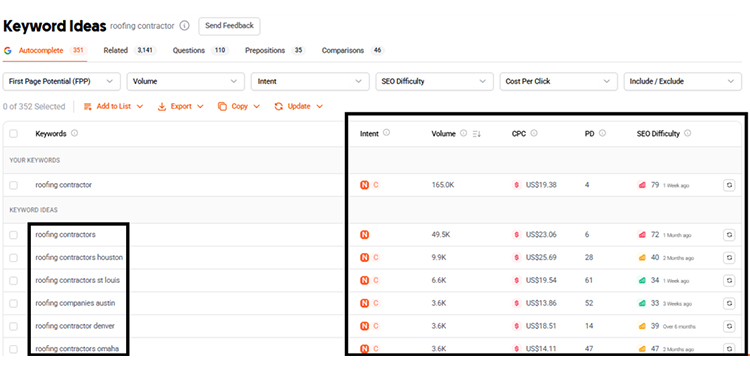
| Metric | Definition | Tips to Choose the Best Keywords |
| Search Volume | Average number of times a keyword is searched monthly on search engines. | Pick relevant keywords with decent volume (not too low), but make sure they are relevant to your contractor SEO campaign. You need to target Local keywords that may have lower volume but higher conversion. |
| CPC (Cost Per Click) | The average amount advertisers pay per click in Google Ads for that keyword. | High CPC = keyword has strong commercial value. For Contractor SEO, a balance between high CPC (good leads) and low competition is much needed. |
| SEO Difficulty | A score (0–100) showing how hard it is to rank organically for a keyword. | Target low to medium difficulty (20–40) when starting. Mix a few higher-difficulty keywords for long-term growth. |
| PD (Paid Difficulty) | A score (0–100) showing how competitive it is to run ads for that keyword. | Lower PD = easier and cheaper for paid campaigns. If PD is high, focus on organic rankings instead. |

Search intent is what a person really wants to find when they use a search engine. What they really want to do is more important than the words they type.
There are four main types:
- Informational intent (to learn something, e.g., “how to fix a leaky pipe”)
- Navigational intent (to reach a specific site, e.g., “Home Depot website”)
- Transactional intent (ready to buy, e.g., “buy roofing nails online”)
- Commercial investigation (comparing before purchase, e.g., “best contractor in Dallas reviews”).
This search intent makes you understand what your target market wants. And then put those kinds of words.
Questions are the best option if you develop informational content and FAQs (great for blog topics).
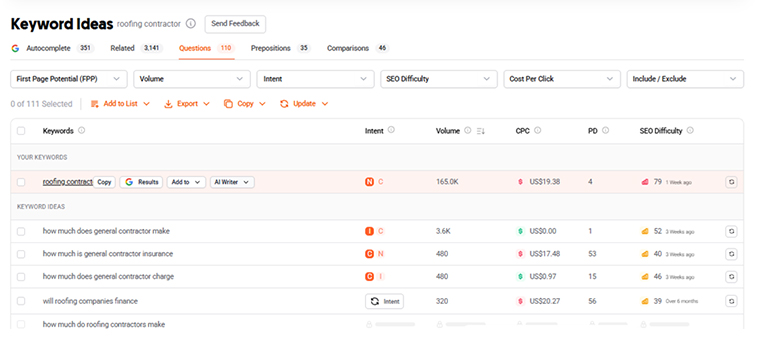
- Export the list (CSV) and add it to your master spreadsheet. Tag each keyword with intent, priority, and assigned page.
- Compare competitor domains inside Ubersuggest to see which keywords they rank for — look for gaps you can exploit.
- Then you can repeat with 5–10 seed phrases (service types + neighborhood names) to build a robust list.
- How to Map & Incorporate Keywords into Your Contractor SEO Campaign?
- Google Business Profile: You can include exact service-related keywords and the city in the services list and short description.
- Service pages: Then you need to place the primary target keyword in the title, H1, first 100 words, schema markup, and alt text of project photos.
- Location pages: This is very important for local SEO for contractors. You need to put together one page for major service areas with localized copy, testimonials from that area, and project photos.
- Blog/FAQ: Moreover, you can target informational queries (from the Ubersuggest “Questions” tab) to capture early-stage searchers. Additionally, if you regularly update your blog and FAQ sections, it can help you to develop authority and expertise in your field.
Monitor keyword rankings & conversions with Google Search Console + a local rank tracker (BrightLocal or similar). You have to adjust pages as local rankings change.
- Content Marketing for Contracting Business
Local SEO for contractors is the key to being found online by customers in your area. Your website will be noticed and ranked higher by search engine algorithms when you produce useful content. If more people in your area search for contracting services like yours, they will be able to find your business.
Content marketing helps general contractors acquire reliability before customers even make phone calls. A lot of people will choose your business over others if they see that you know what you’re talking about in blog posts and guides.
- Best Content Types for Local Services
Educational Blog Posts- First, you need to create blog posts that answer common questions your customers ask. Write about:
- “How to prepare your home for a renovation”
- “Warning signs your roof needs repair”
- “Winter maintenance tips for homeowners”
These topics help with contractor SEO because people search for this information online. When your website’s content answers their questions, Google puts it higher in the search results.
Local Project Showcases-Then you can show off your completed projects in your service area. Include before and after photos, project details, and customer testimonials. This content works great for local SEO because it includes location-specific information.
Seasonal Content-You should write about services that go with the season. You can increase your local clientele throughout the year by posting blogs about your niche business related to holidays, events, or weather changes.
- How to Optimize Content for Local Search Results?
- Use Location Keywords-Include your city and neighborhood names in your content. Do not just write “roofing services,” but also write “roofing services in [Your City].” This helps local businesses show up higher in searches for them.
- Answer Local Questions-Moreover, you can write about local building codes, weather challenges, and community projects. This indicates to search engines that you understand your local market and helps improve your search rankings.
- Include Contact Information-Always include the name, address, and phone number of your business in your writing. For contractors, this helps with local SEO and makes it easy for customers to get in touch with you.
- Produce Well-Informed Content That Converts
- Keep It Simple—Your content should be easy to understand and well-researched. You can create content for multiple cities with their local features. Like if you’re a contractor of HVAC services, then you need to find out the core points of a specific area.
- Most importantly, use easy words and short sentences. Your customers want clear information, not complicated technical language. You can explain things like you’re talking to a neighbor.
- Add Photos and Videos
Text-only content doesn’t work as well as visual material. Show how you work, projects you’ve finished, and people on your team. This helps people believe you, which makes them more likely to hire you.
- Include Call-to-Actions
Always leave readers with a clear idea of what to do next. People should call you to get a free price, set up a meeting, or get a useful guide.
- How Do Local Citations Build Your Contractor Authority
Local citations are mentions of your business name, address, and phone number (NAP) on other websites. These citations serve as online references that show search engines that your company is legitimate and reliable. They improve your location-based searches and help potential customers find your local services.
Your website will also get more visitors because the local citations give people more ways to find your business. Search engines show your web pages higher in local results when they are on more than one credible site with the same information.
- Top Citation Sources for General Contractors
- Google Business Profile (most important)
- Yelp and the Better Business Bureau
- Angie’s List and HomeAdvisor
- Yellow Pages and Whitepages
- Facebook Business Page
These platforms generate quality local leads because customers actively search for contractors on these sites.
- Nap (Name, Address, Phone) Consistency Importance
Your business address and phone number will be shown like this on the Yelp online platform.
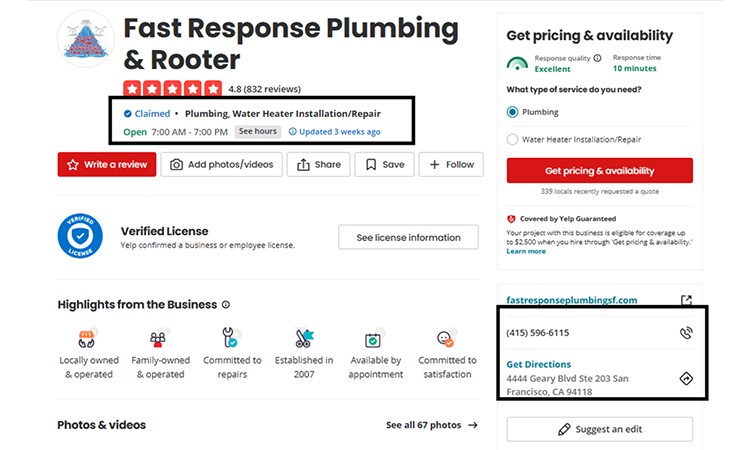
You need to keep your contracting business name, address, and phone number identical across all citations. Little differences like “St.” vs. “Street” can make search engines confused, which can hurt your results. Consistent NAP information generates reliability and improves your online visibility in location-based searches.
- Industry-Specific Online Directories and Platforms
Target contractor-specific directories for better results:
- BuildZoom and Thumbtack
- Local Chamber of Commerce
- State contractor licensing boards
- Industry association websites
- Local newspaper business directories
These specialized platforms attract customers specifically looking for local services in your field.
- Where to Get the Best Local Citations?
- You can start with free citations on Google, Yelp, and Facebook.
- Then expand to paid directories like Angie’s List if they generate quality leads in your area.
- Pay attention to neighborhood-specific magazines, websites for business groups, and community bulletin boards.
- Quality citations from other websites will consistently generate more website traffic and local leads to your contracting business.
- Leverage Existing Customers for Local SEO Success
Reviews are very important to expand your contractor SEO success. In this segment, you will learn how you manage your online reviews. It is one of the significant SEO strategies for contractors.
- Implement Review Generation Strategies
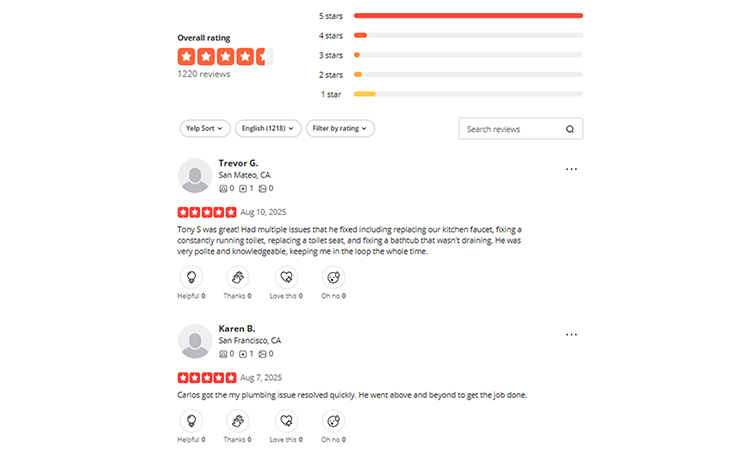
Your best marketing tool is your happy customers. General contractors who actively request reviews see 3x more positive reviews than those who wait for customers to leave feedback naturally. To make a system, you should ask for reviews right after the project is finished, when customer satisfaction is at its highest.
Strategically time your requests: send the first one 24 hours after the project is done, and then a gentle reminder a week later. This time captures the highest level of happiness and develops your online reputation before memories fade.
- Automated Review Request Systems
Set up automated email sequences that trigger after project milestones. To get the best results, you can add direct links to Google, Yelp, and Facebook review pages to make the process effortless for customers. Contracting business owners who automate this method can generate a huge amount more than those who use manual approaches.
Use project management software to automatically send review requests when you mark jobs as “complete.” This ensures no satisfied customer slips through the cracks.
There is a 9% increase in the company’s revenue for every additional one-star Yelp rating.

- Response Templates for Positive/Negative Reviews
Positive review template: “Thank you [Customer Name] for choosing [Business Name]! We’re thrilled you’re happy with your [specific project]. We look forward to helping you with future projects.”
Negative review response: “Hi [Customer Name], thank you for your feedback. We take all concerns seriously. Please contact us at
so we can make this right. We value your business and want to exceed your expectations.”Quick, professional responses show potential customers you care about satisfaction and can attract more customers.
- Review-to-Conversion Optimization
Moreover, you can highlight positive reviews prominently on your website homepage and service pages. Then, publish dedicated testimonial pages for each service area if you serve multiple cities. This local social proof has a direct effect on your SEO strategy. It will keep people on your site longer and lower conversion rates.
- Create Case Studies and Testimonials
- You can convert your best customer experiences into detailed case studies.
- Then you can add before/after photos, project challenges, solutions provided, and customer quotes. As part of a local SEO for contractors strategy, these in-depth success stories are great content that ranks well for local searches and increases legitimacy.
- You need to make videos of customer testimonials. They work better than written reviews and help your local search rankings a lot. If you have loyal customers, they will help you dominate local search results and become your most reliable marketing team.
- Social Media Local Engagement
- Social Media Local engagement is a powerful way for contractors to connect with nearby customers, establish reliability, and increase visibility. You can develop platform-specific content strategies, and you can maximize results.
- On Facebook, share before-and-after project photos, post client reviews, and run local ads targeting your service area.
- On Instagram, use stories and reels with hashtags like #roofrepair[city] or #plumber[city] to reach homeowners.
- Professional updates should be posted on LinkedIn, and you should connect with local businesses to get contacts.
- Another key strategy is local community group participation. You can join neighborhood Facebook groups, Nextdoor, or local forums where homeowners actively seek contractor recommendations.
- Then give helpful advice, answer questions, and share tips instead of only promoting your services.
- In your city, this sets you up as the authority and promotes integrity. You need to consistently engage on these platforms to drive more local customers and expand your online reputation, and support long-term contractor SEO efforts.
- Advanced Strategies To Improve Local SEO For Contractors
Competitor keyword gap identification discloses untapped opportunities by analyzing what keywords your competitors rank for that you don’t. You can use tools like Semrush or Ahrefs to discover high-value local keywords like “emergency contracting services [city]” or “roofing contractors near me” that competitors dominate.
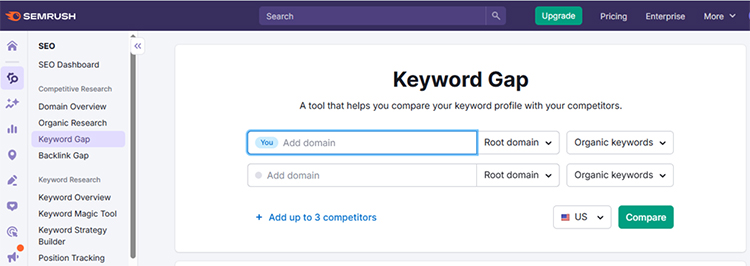
You can go to Semrush Keyword Gap-> Put your main domain and your rival domain. It will show which keywords are ranking best and what your rivals use, but you don’t. Add those keywords to attract more customers.

Local SERP feature optimization focuses on capturing Google’s local pack, featured snippets, and “People Also Ask” sections. You can develop frequently asked questions (FAQ) pages for contractors and use consistent NAP data to optimize for map pack exposure.
Market share analysis helps identify underserved neighborhoods or services in your area. If competitors focus on residential work, target commercial keywords like “commercial HVAC repair [city]” to capture overlooked opportunities.
- Multi-Location SEO (For Expanding Contractors)
- Location-specific landing page templates should include unique content for each service area. Develop pages like “/roofing-services-downtown-chicago” with local landmarks, neighborhood-specific testimonials, and area construction code information.
- Local inventory and service variation optimization refers to emphasizing services that are well-liked in particular regions.
- You can coordinate regional advertising to connect pay-per-click (PPC) campaigns with contractor SEO initiatives in many places. This keeps messages consistent and stops keywords from being used in too many places.
- Voice Search and Mobile-First Optimization
- Conversational keyword integration targets how people actually speak: “Who’s the best contractor near me?” instead of “best contractor [city].” Include natural question phrases in your content.
- Featured snippet optimization captures voice search results by structuring content with clear headers, bulleted lists, and concise answers to common questions like “How much does roof repair cost?”
- Local voice search query targeting focuses on mobile users asking, “Where can I find a reliable electrician?” or “What contractors are open now?” Optimize for immediate needs with location-based emergency services content.
These advanced local SEO for contractors’ strategies help general contractors stay ahead of competitors and capture the growing mobile and voice search market.
How To Maintain Your Website to Improve Local SEO For Contractors?
You have to maintain your contractor website for the best local SEO, which requires consistent attention to technical details, user experience, and local optimization factors. To be successful at search engine optimization, you need to follow these steps carefully and keep an eye on how they change your search rankings.
When local businesses do these maintenance tasks, their online visibility, lead generation, and customer acquisition always get a lot better. You need to always remember that SEO for contractors is an ongoing process that needs to be updated and improved on a regular basis to stay ahead of the competition in local markets.
The key to long-term contractor SEO success lies in treating website maintenance as an investment in your business growth, not just a technical necessity.
- Meta descriptions and Meta Title tags

The way your website shows up in search engine results is directly impacted by meta titles and meta descriptions, which are essential components of on-page SEO for contractors.
- Meta Title Tag: This is the clickable headline shown in search engines. A strong title should include your target keywords, be under 60 characters, and clearly describe the page. Example: “Roof Repair Services in Dallas | Trusted Roofing Contractor.” You need productive titles to improve search rankings and increase click-through rates.
- Meta Description: This is the summary (about 150–160 characters) that appears below the title. It should incorporate relevant keywords naturally, explain what the page is about, and encourage users to click. Example: “Expert roof repair in Dallas. Affordable, reliable contractors to fix leaks and damage. Call today for fast service!”
Both are important because they introduce search engines to your page. Meta descriptions don’t directly affect local search results, but they do increase clicks and contractor SEO strategy success.
- Heading Optimization for Contractor Websites
- H1 Tag Strategy
Use only one H1 per page with your primary keyword and location. Example: “Professional Roofing Contractors in Chicago” instead of generic “Welcome to Our Website.”
- H2 Structure for Services
Create H2 tags for each major service: “Residential Roofing Services,” “Commercial HVAC Installation,” “Emergency Plumbing Repair.” Include location modifiers when relevant.
- H3 Subheadings for Details
Use H3 tags for specific service details: “Asphalt Shingle Installation,” “Metal Roofing Repair,” “24/7 Emergency Services.”
- Local SEO For Contractors Heading Tips
- Include city names in headings naturally
- Use “Near Me” variations in H2 tags
- Add service area neighborhoods in H3S
- Keep headings under 60 characters for better display
- Common Mistakes to Avoid in Incorporating Headings
- Don’t skip heading hierarchy (H1→H2→H3)
- Avoid keyword stuffing in headings
- Don’t use multiple H1 tags per page
- Never use headings just for styling
You need to properly optimize headings to improve user experience and search rankings significantly.
- Mobile-First Design for Local Searches
Your website has to be user-friendly and mobile-optimized. Here are some best tips that help you make your website content and pages mobile-friendly.
- Tips To Make Your Website Mobile-Friendly
Step 1: Responsive Design Testing
- Use Google’s Mobile-Friendly Test tool (search.google.com/test/mobile-friendly).
- Test all website pages on different device sizes.
- Ensure buttons are at least 44px for easy tapping.
- Verify text remains readable without zooming.
Step 2: Touch-Friendly Navigation
- Create thumb-friendly menus for easy navigation.
- Place contact buttons prominently above the fold.
- Implement click-to-call functionality for phone numbers.
- Use large, clear fonts (minimum 16px).
Step 3: Local Mobile Optimization
- Optimize for “contractor near me” searches.
- Create mobile-specific call-to-action buttons.
- Ensure Google Maps integration works seamlessly.
- Best Tools:
- Google Mobile-Friendly Test
- BrowserStack for cross-device testing
- GTmetrix Mobile Analysis
- PageSpeed Insights Mobile section
- Page Speed Optimization for Better User Experience
Page speed directly impacts search engine optimization results. Your website has to load within under 3 seconds to see higher conversion rates, while slow sites lose potential clients to competitors. Google sees page speed as a ranking factor for local directories and local search results.
- Technical Implementation Steps
Step 1: Image Optimization
- Compress images to under 100 KB using TinyPNG or JPEGoptim.
- Use the WebP format for 25-35% better compression.
- Implement lazy loading for images below the fold.
- Optimize hero images on service area pages for fast loading.
Step 2: Code Optimization
- Minify CSS, JavaScript, and HTML files.
- Remove unused plugins and scripts.
- Enable GZIP compression on your server.
- Use a Content Delivery Network (CDN) like Cloudflare.
Step 3: Caching Implementation
- Install caching plugins (WP Rocket for WordPress).
- Enable browser caching with proper expiry headers.
- Implement server-side caching.
- Use database optimization tools.
Step 4: Core Web Vitals Optimization
- Largest Contentful Paint (LCP)
- What it is: Measures how long it takes the main content (like a hero image, headline, or banner) to fully load and become visible.
- Good score: Under 2.5 seconds.
- Why it matters: A fast LCP means users can see and engage with your page quickly.
- First Input Delay (FID)
- What it is: Measures the time between a user’s first interaction (like clicking a button or link) and the browser responding.
- Good score: Under 100 milliseconds.
- Why it matters: Low FID ensures your site feels smooth and responsive.
- Cumulative Layout Shift (CLS)
- What it is: Measures how much the page layout shifts while loading (e.g., text or buttons moving around).
- Good score: Under 0.1.
- Why it matters: A low CLS prevents users from clicking the wrong thing by mistake.
- Best SEO Tools To Check Site Speed:
- Google PageSpeed Insights
- GTmetrix
- WebPageTest
- Lighthouse Chrome Extension
- Local Schema Markup Implementation
Rich snippets show up higher in search engine results when schema markup is used. This is code that helps search engines better understand your content. Local businesses using schema markup see 30% higher click-through rates from search results.
- How To Implement Local Schema Markup?
Step 1: Local Business Schema
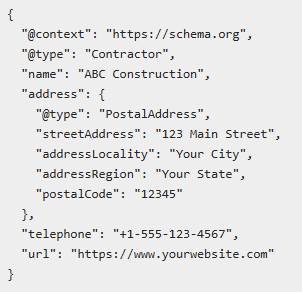
Step 2: Service Schema for Each Service Area Page-You can add a specific schema to individual service pages, like roofing, plumbing, or electrical work. Then you need to add service area, pricing ranges, and availability.
Step 3: Review Schema Implementation-Then you need to set up a review schema to display star ratings in search results to improve click-through rates.
- Best Tools:
- Google’s Structured Data Testing Tool
- Schema.org documentation
- JSON-LD Schema Generator
- Rich Results Test
- Canonical Tags Implementation
If you want to tell search engines which version of a page is the main one, you use a canonical tag. It helps websites avoid duplicate content and maintain their rightful page rankings.
Step 1: Prevent Duplicate Content
- Add canonical tags to all pages.
- Use self-referencing canonicals on unique pages.
- Point similar pages to the most comprehensive version.
- Implement canonical tags for location-specific pages.

- Breadcrumb Navigation
Breadcrumb navigation is an easy part of websites that tells users where they are in the site’s hierarchy by showing them links that they can click on, like “Home > Services > Roofing.”
Step 1: Create Logical Hierarchy
- Implement breadcrumbs on all service pages.
- Use schema markup for breadcrumbs.
- Create clear navigation paths:Home > Services > Roofing > Metal Roofing
Step 2: Breadcrumb Schema

- Robots.txt Optimization
To improve robots.txt, you need to add to or change the robots.txt file on your page so that search engines know what to do. It tells crawlers which pages to index or block, improving crawl efficiency and SEO and preventing duplicate or sensitive pages from being indexed.
Step 1: Create a Proper Robots.txt

Step 2: Strategic Blocking
- Block unnecessary admin pages.
- Allow all important website pages.
- Include XML sitemap location.
- Test with Google Search Console.
- Develop Location-Specific Landing Pages
Here, you can get the strategic location-oriented Page creation to uplift the online presence of contractors.
Step 1: City-Specific Landing Pages- You may develop individual pages for each major city you serve:
- “Roofing Contractors in [City Name]”
- Include city-specific keywords in titles and meta descriptions.
- Add local testimonials and project photos.
- Reference local landmarks and neighborhoods.
Step 2: Service + Location Combination Pages-You can develop pages combining services and locations.
- “Emergency Plumbing Services in Downtown [City]”
- “Commercial HVAC Repair in [Business District]”
- Optimize for long-tail local keywords.
- Include local emergency contact information.
Step 3: Neighborhood-Level Optimization
- Create pages for specific neighborhoods.
- Include local demographic information.
- Add neighborhood-specific web pages.
- Reference local community events and associations.
Content Strategy for Location Pages to Improve the website’s visibility
Step 1: Unique Content Creation
- Write unique descriptions for each location.
- Include local success stories and case studies.
- Add location-specific FAQs.
- Reference local suppliers and partnerships.
Step 2: Local Keywords Integration
- Research location-specific search terms.
- Include “near me” optimization.
- Add local modifier keywords naturally.
- Optimize for mobile voice searches.
- Internal Links Are Crucial for Your Contractor Website
You can get from one page of your website to another page on the same website using internal links. Search engines can better understand your site’s structure with their help, and important pages will get better keyword rankings.
Strategic Internal Linking
Step 1: Service Page Interconnection
- You can link all web pages together (roofing to gutters).
- Create logical service hierarchies.
- Use descriptive anchor text with keywords.
- Link from high-authority pages to newer content
Step 2: Location-Based Linking
- Link service pages to relevant location pages.
- Connect city pages to neighborhood pages.
- Create hub pages for major service areas.
- Link testimonials to relevant service and location pages.
Step 3: Content Silo Structure Organize content into logical silos:
- Residential Services → Individual Service Pages → Location Pages
- Commercial Services → Industry-Specific Pages → Service Areas
- Emergency Services → 24/7 Service Pages → Coverage Areas
Link Building Best Practices
Step 1: Authority Distribution
- You can link from the homepage to the most important web pages
- Distribute link equity to location-specific pages.
- Use contextual internal links within content.
- Create comprehensive resource pages with internal links.
Step 2: Anchor Text Optimization
- Use varied, descriptive anchor text.
- Include local keywords in internal link anchors.
- Avoid over-optimization with exact match anchors.
- Use branded anchors for homepage links
- HTTPS & Security Maintenance-SSL Certificate Implementation
Encrypting the data sent between a website and a visitor’s browser is what HTTPS and SSL certificate implementation do to protect a website. It keeps private information safe, increases confidence, and helps websites do better in search engines than HTTP sites that aren’t secure.
You can think of HTTPS like a lock on your diary. Your secrets can be read by anyone if you don’t have an SSL certificate. Your messages, passwords, and payments are safe when you use a website because HTTPS locks hackers out.
Step 1: SSL Installation
- Install an SSL certificate from a reputable provider
- Redirect all HTTP pages to HTTPS versions
- Update all internal links to HTTPS
- Submit HTTPS sitemap to local directories
Step 2: Security Headers Implement essential security headers:
- Content Security Policy (CSP)
- HTTP Strict Transport Security (HSTS)
- X-Frame-Options
- X-Content-Type-Options
Ongoing Security Maintenance
Step 1: Regular Updates
- Update CMS, plugins, and themes monthly
- Install security plugins (Wordfence for WordPress)
- Perform regular malware scans
- Backup website data weekly
Step 2: Monitoring and Maintenance
- Monitor Google Search Console for security issues
- Check search engine rankings regularly for drops
- Set up uptime monitoring alerts
- Review access logs for suspicious activity
Best Security Tools:
- Cloudflare for DDoS protection
- Sucuri for malware scanning
- UpdraftPlus for backups
- Google Search Console for security alerts
How to Track and Improve Your Local SEO For Contractors?
Step 1: Ranking Monitoring
- Monitor search engine rankings for target keywords.
- Tracking local pack positions
- Analyze service pages’ performance
- Compare with competitor rankings
Step 2: Traffic Analysis
- Use Google Analytics for traffic insights
- Track mobile vs desktop performance
- Monitor page speed improvements
- Analyze user behavior patterns
Continuous Improvement
Step 1: Monthly Maintenance Tasks
- Update contact information accuracy
- Review and refresh meta descriptions
- Check internal link functionality
- Analyze page speed performance
Step 2: Quarterly Optimization
- Audit all location-specific pages
- Update schema markup as needed
- Review security certificates and headers
- Optimize underperforming service pages
Let’s Conclude Our Discussion
Local SEO for Contractors is a long-term process. You cannot expect results within 10-15 days. Search engine optimization gives the most sustainable and successful results for various local businesses, like contractors.
Yes, you can design your own local contractor SEO strategy. However, the professional guidance from the best digital marketing company can enhance your local SEO strategy for contractors. Their expertise and experience can help you navigate the ever-changing landscape of search engine algorithms and ensure that your website is optimized for maximum prominence.
Go and execute the local SEO approaches and establish your contracting business at the top of the search bar, and win jobs in your service area.


